
Sassafras is a genus of three extant and one extinct species of deciduous trees in the family Lauraceae, native to eastern North America and eastern Asia. The genus is distinguished by its aromatic properties, which have made the tree useful to humans.

The Canellaceae are a family of flowering plants in the order Canellales. The order includes only one other family, the Winteraceae. Canellaceae is native to the Afrotropical and Neotropical realms. They are small to medium trees, rarely shrubs, evergreen and aromatic. The flowers and fruit are often red.
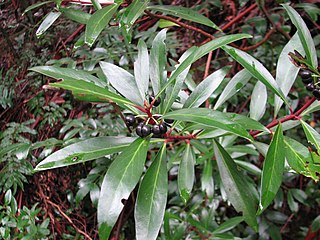
Tasmannia is a genus of about 36 species of flowering plants in the family Winteraceae, and is native to Australia and New Guinea, with one species also found in parts of Southeast Asia. Plants in the genus Tasmannia are shrubs or small trees, usually dioecious with simple leaves, mostly white, sometimes yellow flowers, and one to many clusters of berries.

Backhousia citriodora is a flowering plant in the family Myrtaceae, genus Backhousia. It is endemic to subtropical rainforests of central and south-eastern Queensland, Australia, with a natural distribution from Mackay to Brisbane.

Kunzea pomifera, commonly known as muntries, emu apples, native cranberries, munthari, muntaberry or monterry, is a low-growing or prostrate shrub with hairy stems, small, mostly egg-shaped leaves, groups of white flowers on the ends of the branches and fleshy, more or less spherical, edible fruit.
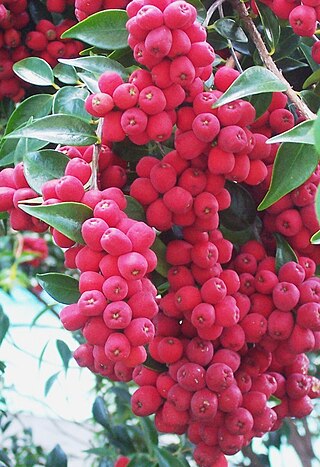
Syzygium luehmannii is a medium-sized coastal rainforest tree native to Australia. Common names include riberry, small leaved lilly pilly, cherry satinash, cherry alder, or clove lilli pilli.

Eucalyptus olida, commonly known as strawberry gum or sometimes as forest berry, is a species of small to medium-sized tree that is endemic to a restricted area of New South Wales, Australia. It has rough, flaky and fibrous bark on the trunk and larger branches, lance-shaped to curved adult leaves, flower buds in groups of seven to fifteen or more, white flowers and barrel-shaped or bell-shaped fruit.

Tasmannia stipitata, commonly known as northern pepperbush is a flowering plant in the family Winteraceae and is endemic to eastern Australia. It has narrowly lance-shaped to narrowly elliptic leaves and male and female flowers on separate plants, the male flowers with 21 to 65 stamens and the female flowers with 2 to 9 carpels. The fruit is bluish-violet and contains 12 to 15 seeds.

Melaleuca lanceolata commonly known as black paperbark, moonah, Rottnest Island teatree and western black tea tree is a plant in the myrtle family, Myrtaceae and is native to Australia where it occurs in Western Australia, South Australia, Victoria, New South Wales and Queensland. It is a densely foliaged tree with rough bark, which flowers prolifically in summer.

Austromyrtus dulcis is a species of plant native to eastern Australia. It grows as a small spreading shrub and is easily recognised by its characteristic berries that usually ripen in summer and autumn. Common names include the midgen berry, midyim, and silky myrtle.
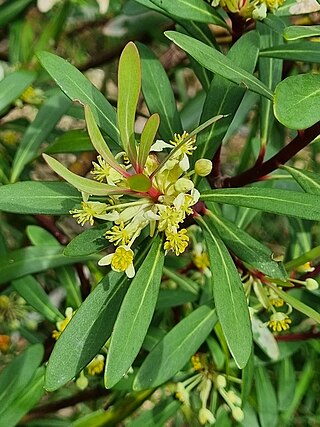
Tasmannia xerophila, commonly known as alpine pepperbush, is a species of flowering plant in the family Winteraceae and is endemic to south-eastern continental Australia. It is a bushy shrub to small tree with lance-shaped leaves, the narrower end towards the base. Male and female flowers are borne on separate plants, the male flowers with 9 to 30 stamens and the female flowers with up to 8 carpels. The fruit is glossy black and contains 2 to 7 seeds.

Diospyros australis is the most southerly of the group of some 450 ebonies and persimmons. It is a shrub or small tree growing in rainforests of seaward eastern Australia. The habitat is in a variety of different rainforest forms, though not often seen in the cool temperate rainforests. The range of natural distribution is from Durras Lake near Batemans Bay in south east New South Wales, to Atherton in tropical Queensland.
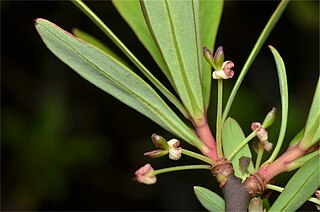
Tasmannia glaucifolia, commonly known as fragrant pepperbush, is a species of flowering plant in the family Winteraceae, and is endemic to New South Wales. It is a dioecious shrub with lance-shaped leaves, the narrower end towards the base, the flowers usually without petals, male and female flowers on separate plants and the fruit is a glossy, deep purple-black berry.
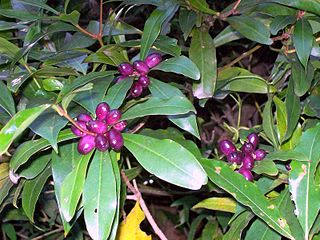
Tasmannia insipida, commonly known as brush pepperbush, Dorrigo pepper, pepper bush, pepper tree or faint pepper bush, is a species of flowering plant in the family Winteraceae, and is endemic to eastern Australia. It is a shrub or small tree with lance-shaped or egg-shaped leaves the narrower end towards the base, the flowers male and female flowers on separate plants, male flowers with 17 to 65 stamens, female flowers with a single carpel with 15-40 ovules, and the fruit a purplish berry.

Tasmannia membranea, commonly known as pepper tree, is a species of flowering plant in the family Winteraceae, and is endemic to north-eastern Queensland. It is a shrub or tree with lance-shaped or egg-shaped leaves, male and female flowers on separate plants, with two petals on each flower. The male flowers have 30 to 62 stamens, and the female flowers have a single carpel with 14 to 36 ovules, and the fruit is black.

Tasmannia vickeryana, commonly known as Baw Baw pepper, is a species of flowering plant in the family Winteraceae and is endemic to Victoria in Australia. It has narrowly lance-shaped leaves, sometimes with the narrower end towards the base, and male and female flowers on separate plants, the male flowers with 8 to 26 stamens and the female flowers with up to 5 carpels. The fruit is dark red and contains 2 to 5 seeds.

Hovea lanceolata is a flowering plant in the family Fabaceae. It is a small shrub with elliptic leaves and purple pea flowers. It grows in New South Wales and Queensland.
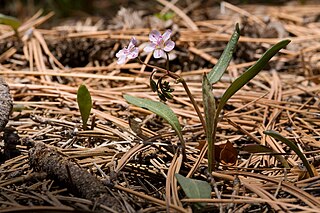
Claytonia rosea, commonly called Rocky Mountain spring beauty, western springbeauty or Madrean springbeauty, is a diminutive spring blooming ephemeral plant with pale pink to magenta flowers. It grows a small round tuberous root and it one of the earliest wildflowers of spring in its range. It is found in dry meadows in forests of ponderosa and Chihuahuan pines, and moist ledges of mountain slopes of the Beaver Dam Mountains of Utah, Colorado Front Range, and Sierra Madre Occidental, south and east to the Sierra Maderas del Carmen of Coahuila.




















